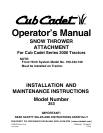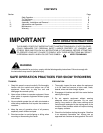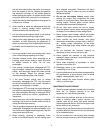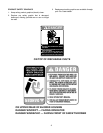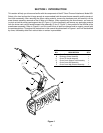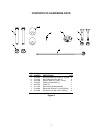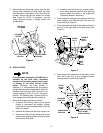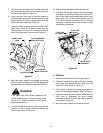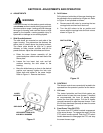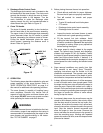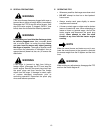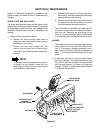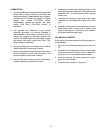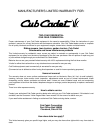
12
3. Discharge Chute Control Crank
The discharge chute control crank is located on the
left hand side of the snow thrower. The chute crank
controls the direction in which the snow is thrown.
The discharge radius is 190 degrees. Turn the
crank clockwise to rotate the discharge chute
opening toward the left, and counterclockwise to
rotate toward the right. Refer to Figure 13.
4. Chute Tilt Handle
The chute tilt handle assembly is also located on
the left hand side of the snow thrower assembly.
The upper chute of the discharge chute assembly
pivots downward when the tilt handle is pushed
forward, decreasing the distance snow is thrown.
Pulling the handle backwards pivots the upper
chute upward, increasing the distance snow is
thrown. Refer to Figure 13.
Figure 13
C. OPERATION
The following steps describe methods for safe and
proper operation of this snow thrower. Refer to
“SAFE OPERATION PRACTICES” on page 2 of
this manual for additional safe operating practices.
1. The snow thrower is capable of handling heavy
snow conditions. Become fully familiar with all
aspects of both the tractor and snow thrower prior
to its usage. DO NOT remove any guards or covers
while operating the tractor and snow thrower.
WARNING
Whenever the snow thrower is installed on the front
of the tractor, usage of rear weights on the tractor is
recommended to counterbalance the weight of the
snow thrower and provide stability to the tractor.
See “TO THE OWNER” on page 5.
2. Before placing the snow thrower into operation:
a. Check all nuts and bolts for proper tightness.
Be sure that all parts are properly assembled.
b. Test all controls for smooth and proper
operation.
• Tractor lift handle and front hitch system
•PTO switch
• Discharge chute control crank assembly
• Discharge chute tilt control
c. Inspect the tractor and snow thrower to make
certain both are in good operating condition.
d. Fill the tractor’s fuel tank outdoors. Avoid
spilling fuel onto the engine or any other source
of heat or combustion. Do not fill the tank while
the engine is running. Wipe up any spilled fuel
before starting the engine.
3. The auger speed is directly related to the engine
speed. For optimal snow removal and discharge,
maintain high engine R.P.M. (full throttle). Control
the tractor’s ground speed using the forward control
pedal (and cruise control feature, if desired). It is
recommended that the tractor be operated at a slow
ground speed for safer handling and efficient snow
removal.
4. Snow removal conditions vary greatly from light
fluffy snowfall to wet heavy snow. Therefore,
operating instructions must be flexible to fit the
conditions encountered. The operator must adapt
the tractor and snow thrower to the depth of snow,
wind direction, temperature and surface conditions.
5. In deep, drifted or banked snow, it will be necessary
to use full throttle and a slow ground speed. Drive
the auger into the snow, stop and allow the auger to
clear the snow. Repeat this method until a path is
cleared. On the second pass (and each succeeding
pass), overlap the preceding pass enough to allow
the auger to handle the volume of snow without
having to stop the tractor.
6. In extremely deep snow, the snow thrower may be
raised to the transport position, then slowly driven
into the deep snow to remove the top layers first.
However, do not drive the tractor into a snow bank
where the snow has not been cleared to the ground
level. Stop the tractor’s forward movement and
allow the auger to clear the snow. Reverse the
tractor and lower the snow thrower to the ground to
clear the remaining snow. Working with repeated
passes into and out of drifts, even the deepest snow
piles can be cleared.
UPPER CHUTE
DISCHARGE
CHUTE
CHUTE TILT
HANDLE
CHUTE
CRANK
ROD



